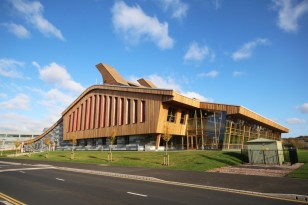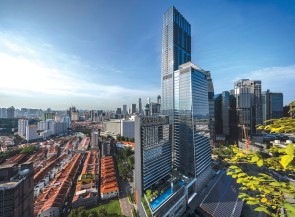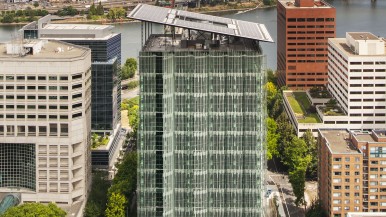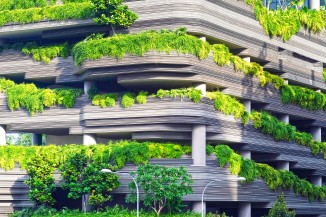Blog / Sustainable Construction
The impact of green buildings on employee performance and well-being
Categories
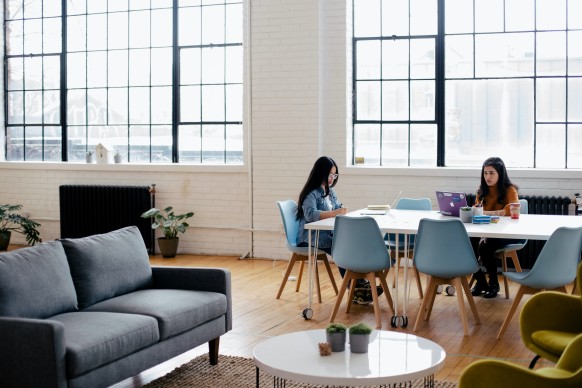
A healthy work environment is more than just a catchy phrase, it's a key driver for employee productivity and well-being.
The placement of green buildings at the heart of this concept is no coincidence. By prioritising sustainability, these eco-friendly structures provide a host of benefits that extend beyond reducing carbon footprint, directly impacting your staff's day-to-day lives in the office.
The design of green buildings fundamentally promotes good health.
How, you may ask? Let’s dive into the specifics.
- Improved ventilation: These structures use effective ventilation systems that continually replenish indoor air, eliminating airborne pollutants and maintaining an optimal level of humidity. This plays a crucial role in reducing the risk of respiratory problems and allergic reactions among employees.
- Temperature control: Green buildings ensure a comfortable and consistent temperature, thanks to high-quality insulation and superior heating and cooling systems. By avoiding the bothersome office too hot, too cold situation, employees can focus fully on their tasks at hand.
- Non-Toxic materials: Materials used in sustainable offices are often free from toxins and harmful chemicals. This safeguards employees from potential health complications related to exposure to synthetic substances.
These elements, alongside the many others that define a green building, create a unique environment where employees flourish.
Understanding the Link between Green Buildings and Employee Performance
You've undoubtedly heard a lot about green buildings, but have you understood what they mean for your employees' performance? Could their increased well-being and productivity be just another added bonus of making the switch to sustainable buildings? The answer is a resounding 'yes', and here's why.
In essence, green buildings are constructed with a strong emphasis on energy efficiency, air quality standards, and consideration for the environment. But what may seem primarily ecological choices can also significantly influence the productivity, health, and happiness of your employees.
The Boost in Performance: Green office spaces have been linked to significant increases in cognitive function, thanks to a combination of improved air quality, access to natural light and views of the outdoors. A study released by the Harvard T.H. Chan School of Public Health shows that employees in green, well-ventilated offices scored 61 percent higher on cognitive function tests compared to those in conventional offices.
In other words, sustainable office spaces aren't simply 'nice-to-haves.' They're instrumental in cultivating better performance and enhancing your employees' day-to-day experience.
So, let's delve into some specific ways green buildings can uplift the performance and well-being of your team:
- Enhanced Air Quality: By prioritising efficient ventilation systems and reducing indoor pollutants, green buildings foster a healthier indoor environment. These standards can reduce common health complaints linked to 'Sick Building Syndrome,' such as headaches, fatigue, and respiratory problems, hence reducing absenteeism and improving overall productivity.
- Improved Lighting: Eco-friendly buildings often incorporate designs that maximise natural daylight. Not only does this reduce energy consumption, it also creates a visually comfortable environment reducing eye strain and enhancing mood, both of which play a significant role in productivity.
- Temperature Control: Green office environments better manage heating and cooling, leading to comfortable temperature ranges. People work best at a specific temperature range, according to a study by Lawrence Berkeley National Laboratory. Any deviation from this range can lead to discomfort and a decrease in productivity.
To sum up, when you make the switch to a sustainable office space, you're not only investing in the planet, but you're also significantly investing in your employees' well-being and productivity. After all, a happy and healthy employee is a productive employee.
The Role of Natural Light in Enhancing Employee Productivity
The impact of natural light on employee productivity is considerably significant. It's not just about making the office appear brighter; there's more to it than meets the eye. Let's shed some light on how this essential element of sustainable design can boost productivity in the workspace.
Steps away from artificial lighting and embracing the glorious sun have long-reaching benefits. The principle here is simple but profound – the more we capitalise on natural light, the lesser we need to rely on artificial light, which not only conserves energy but has several health benefits.
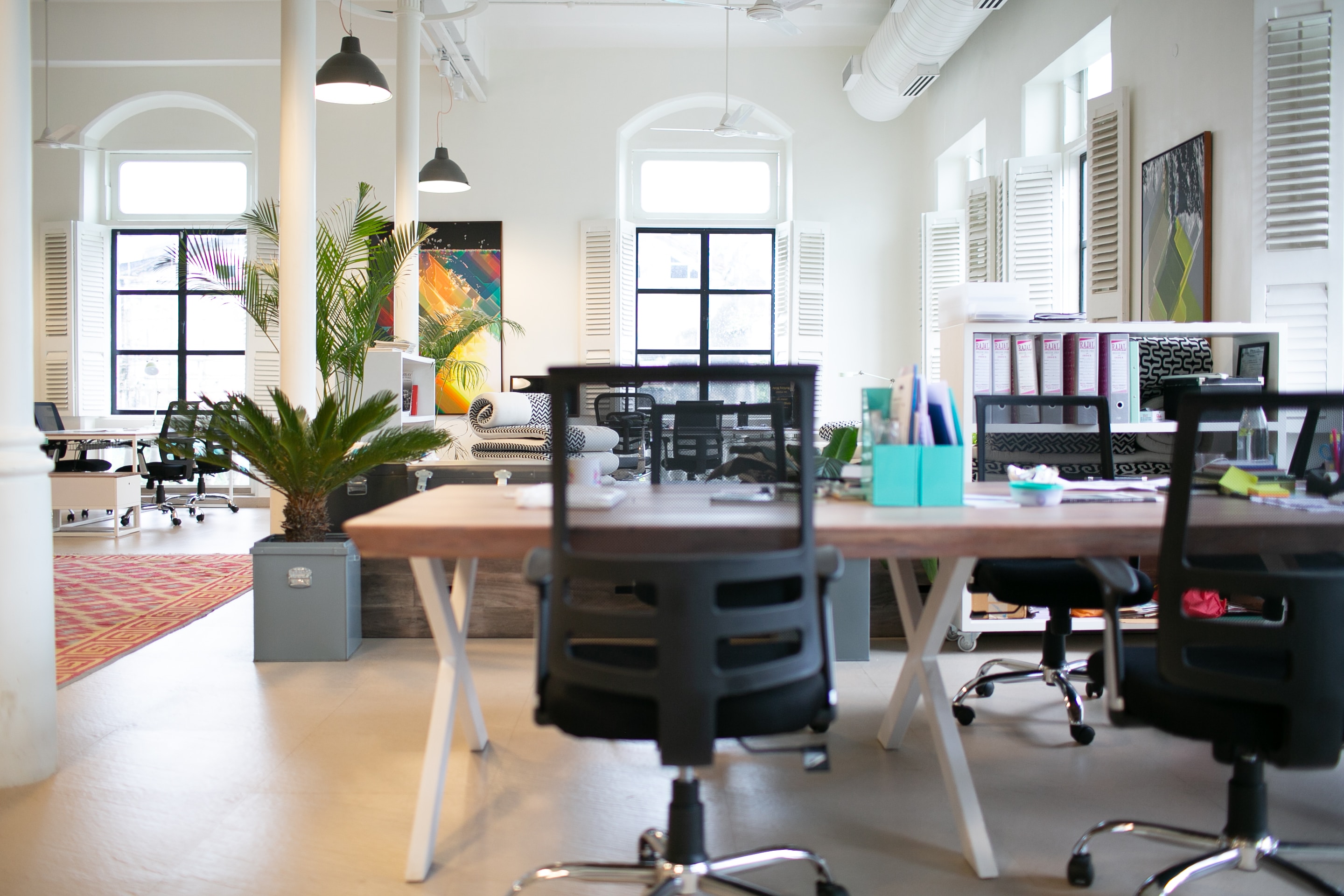
Firstly, exposure to natural light helps maintain our natural circadian rhythms, the internal body clock that governs our sleep-wake cycle. Humans evolved under sunlight, so our bodies still respond best to natural light. A well-lit workspace with plenty of sunshine helps employees maintain a healthy sleep pattern, which in turn results in increased alertness and productivity during work hours.
Secondly, sunlight is a rich source of vitamin D, which is crucial for bone health, immune function, and even mood regulation. Regular exposure to sunlight during work hours can increase workers' vitamin D levels, thereby promoting overall health and well-being.
There's a saying in design that "light is the first of the paintbrushes on the canvas." This couldn't be more fitting when we talk about natural light in the workspace. It not only transforms the aesthetic appeal but also paints a picture of a healthier, brighter, and more productive workspace.
Furthermore, a study conducted by the Interdepartmental Neuroscience program at Northwestern University in Chicago found that the more exposure to daylight an employee had, the better they slept, their quality of life improved, and ultimately their productivity increased.
Besides, there's a calming effect associated with natural light that helps mitigate workplace stress. It reduces eyestrain and the frequency of headaches, thereby decreasing absenteeism due to health issues.
Working in an office flooded with natural light can significantly boost mood and energy, leading to a happier, healthier, and more productive workforce. So, the next time we plan an office renovation or move, it's worth giving this factor some serious consideration.
Improving Air Quality for Better Employee Well-being
Imagine yourself sitting in an office. Does it feel stuffy? Is there a stale smell hanging in the air? Poor indoor air quality is not only unpleasant to endure but it can also severely impact employee well-being and productivity. The good news is, sustainable office designs can ameliorate this issue. Let's explore how.
The Importance of Good Indoor Air Quality
Contaminants such as dust, mould, and harmful volatile organic compounds (VOCs) can proliferate in a poorly ventilated office, causing a myriad of health issues. Symptoms such as headaches, fatigue, allergies, and respiratory problems are common signs of exposure to these pollutants. Beyond the immediate physical impact, poor air quality can also affect cognitive function, impacting productivity and performance.
Sustainable Office Spaces: A Breath of Fresh Air
On the flip side, a well-ventilated office with clean air can do wonders for employee health and efficiency. The elements of a green building work in tandem to promote better air quality. For instance, natural ventilation systems can improve air circulation, while indoor plants can absorb harmful pollutants and release clean oxygen. Eco-friendly materials can also reduce the presence of VOCs, ensuring a healthier working environment.
- Natural Ventilation Systems: By leveraging wind power and the natural flow of air, these systems facilitate the circulation of fresh outdoor air and the expulsion of stale indoor air. This improves the overall air quality and reduces the reliance on energy-hungry HVAC systems.
- Indoor Plants: Indoor foliage doesn’t just beautify the space. Plants like spider plants, chrysanthemums, and peace lilies are nature’s air purifiers, absorbing a range of pollutants and enriching the air with oxygen.
- Eco-Friendly Materials: Traditional office building materials are well-known culprits for off-gassing VOCs. Green buildings opt for low-VOC or VOC-free materials such as bamboo, cork, and recycled metal, reducing pollution levels.
Air Quality Monitoring: An Integral Part of Sustainable Design
Finally, green buildings often incorporate air quality monitoring systems. These provide real-time updates about the air quality and allow for timely interventions if the air quality drops. This can further aid in maintaining a healthy and productive workspace.
To conclude, transforming an office into a sustainable space doesn't just save the planet, it also promotes the health and productivity of everyone within. A breath of fresh air, indeed!
Reducing Noise Pollution: A Key Benefit of Green Buildings
Office spaces are not traditionally associated with tranquillity. With ringing phones, chatty coworkers, and the distant hum of office equipment continuously in the background, it's easy to underestimate the impact of noise pollution on productivity and wellbeing. Green building incorporates design elements that can mitigate these impacts, leading to improved productivity, satisfaction, and well-being.
So, how do green buildings help to reduce noise pollution?
Firstly, sustainability in design extends beyond the use of eco-friendly materials and energy conservation. It also encompasses building acoustics. These consider the reverberation times, or how long it takes for a sound wave to diminish, and the inclusion of sound-absorbing surfaces that can significantly reduce noise levels. Installations such as double-glazed windows, well-insulated walls, and ceilings can further prevent external noise from permeating into the workspace.
Secondly, the landscape surrounding a green building can also provide noise reduction benefits. Trees and plants are excellent natural sound barriers. Strategically placing vegetation around a building can help to diffuse sound waves and absorb noise, creating a more serene and focused work environment.
Remember, a green building is not just about energy efficiency; it's about creating a better environment for everyone on the inside.
Lastly, open floor plans with designated quiet zones can assist in managing noise pollution. Noise levels can be significantly reduced when employees have access to quiet spaces for focused work or conference calls. Additionally, providing employees with high-quality headphones can support individual sound management and increase concentration levels.
While it's impossible to eliminate all noises from an office environment, green buildings can leverage various strategies to significantly reduce noise pollution. By investing in green building design, businesses will not only promote sustainability but also cultivate a quieter, more productive workplace.
Enhancing Workplace Comfort through Sustainable Design
You've certainly heard the phrase, "comfort is key," and when it comes to sustainable workplaces, this affective expression holds true. Incorporating sustainable design features into office spaces can greatly enhance the comfort level, thus, making your employees happier and more productive.
Sustainable design pertains to the integration of environmental, economic, and social-conscious practices into the designing process. The goal is to minimise environmental impact while creating a beneficial ambiance for inhabitants. Specifically, in an office setting, the design focus pivots on employee comfort, health, and productivity.
Arguably, one of the foremost benefits of sustainable design is thermal comfort. Office spaces designed with sustainability in mind often incorporate high-quality insulation, passive solar design, and energy-efficient heating, cooling, and ventilation systems. These features ensure a consistent indoor climate, reducing the likelihood of employees feeling overly hot or cold—which can be a significant distraction.
- Natural Ventilation and Cooling: Offices incorporating natural ventilation systems help create fresh and comfortable environments. These systems regulate indoor temperatures, reduce reliance on air conditioning, and promote energy efficiency.
- Ergonomic Design: Sustainable design also encompasses the selection of furniture. Ergonomic furniture, engineered based on the understanding of human body mechanics, helps to prevent discomfort and reduce the risk of work-related injuries.
- Sustainable Lighting: A combination of natural and artificial light, ideally with options to control light levels, can reduce eye strain and improve mood and productivity.
Moreover, investing in sustainable materials can significantly enhance workplace comfort. Using non-toxic, organic, or recycled materials can provide health benefits and make the space more inviting. These materials also contribute to a more pleasant sensory experience, with improved acoustics and touch-based aesthetics.
Office spaces designed with sustainability in mind pay attention to not only the physical, but also the psychological well-being of their occupants. Design elements can be carefully chosen and positioned to promote positive emotional reactions and improved focus. For instance, strategic placement of green spaces and incorporation of elements like water features or wind chimes can trigger positive psychological responses and a feeling of relaxation.
In the end, sustainable workplaces are more than just environmentally friendly spaces - they are comfort-boosting, health-promoting, and performance-enhancing platforms that ultimately lead to happier, more productive employees.

How Biophilic Design Boosts Employee Happiness and Engagement
Imagine stepping into an office space brimming with freshness where the walls are adorned with living green plants, colourful blooms are cascading from the ceiling and there are patches of reflected sunlight playing around the room. This is the essence of biophilic design, a revolutionary concept that seeks to increase occupant's connectivity to the natural environment.
Biophilic design, which features natural elements such as plants, water, and wood, has been shown to have a transformative impact on employee happiness and engagement at work. It's not just a design trope; it's a bonafide tool to boost workplace morale and productivity.
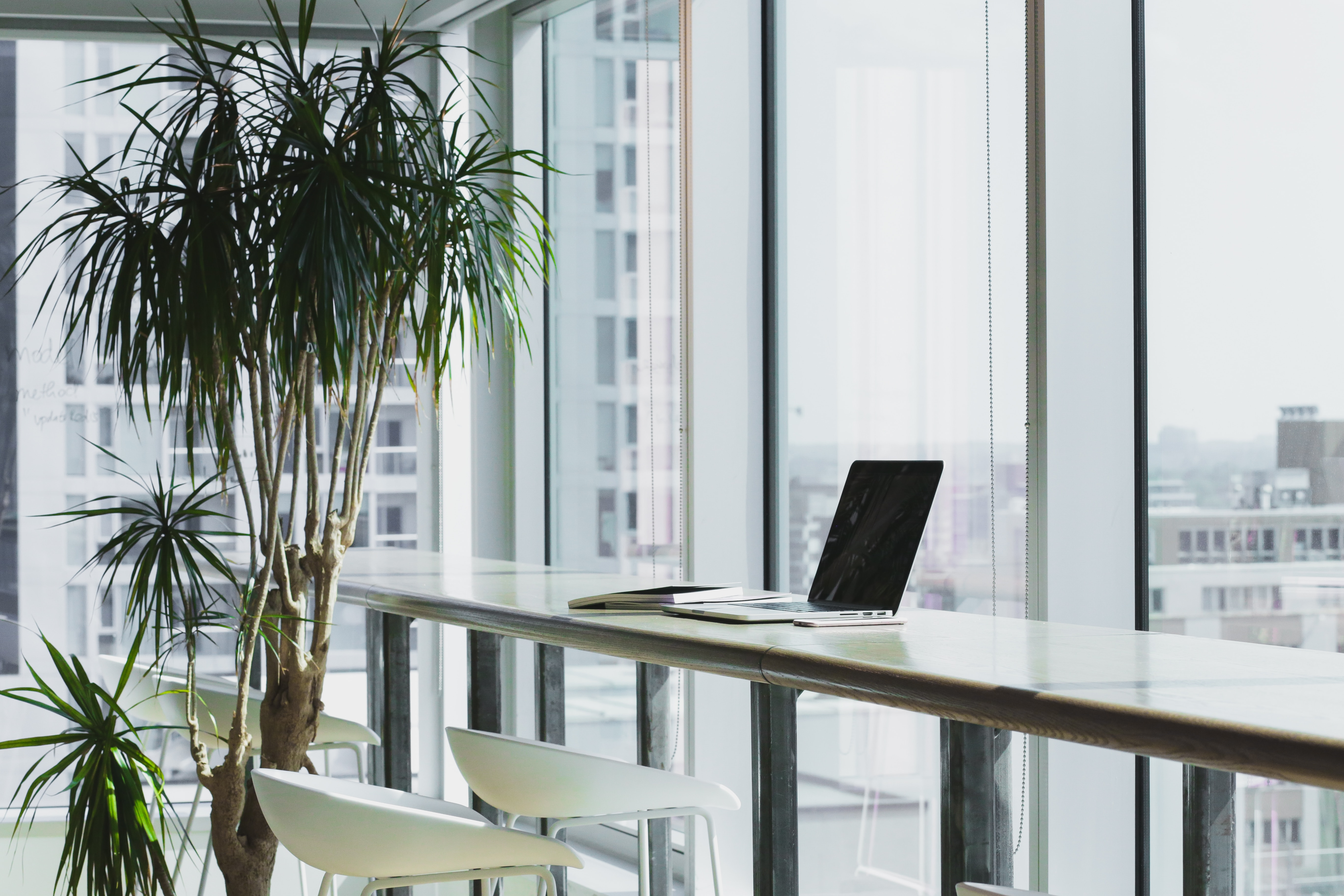
So how does this work?
Let's put you at the heart of this scenario. Firstly, you're going to experience an increase in your concentration levels. Your workspace environment isn't sterile and dull, it stimulates your senses, keeps you alert and energetically engaged in your tasks.
Secondly, there's the psychological aspect - the presence of natural elements has a calming effect. Studies have shown that incorporating elements of nature in the workplace, such as indoor plants, can reduce stress and promote well-being. The end result? Improved emotional stability, fewer sick days, and higher job satisfaction.
Lastly, the biophilic design promotes a sense of community and belonging. Collaborative spaces with green features can encourage interaction and bridge the gap between the employees and their work environment.
"Biophilia is the humankind's innate biological connection with nature. It helps explain why cracking flames and crashing waves captivate us; why an open parkland is preferred over a city street."
- Erich Fromm, Psychologist
Moreover, biophilic design is an investment towards healthier and happier teams, which in the long term, translate into better business productivity and performance. It's a rewarding experience for both the employees and the organisation as research cinches that offices abound with nature have workers who are happier, healthier, and more productive.
Long gone are the days of the monotonous cubicle farms. The future graces us with invigorating green spaces that are, in essence, a boon for upscaling the work ethics and mental health of employees.
The Psychological Impact of Green Spaces in the Office
Ever wondered how the psychological aspect factors into the greening equation in the workplace? Research suggests that it plays a vital part. Rather than being surrounded by grey, sterile walls, introducing green features can evoke a sense of calm and comfort in employees. Colour psychologists even swear by the power of green tones to reduce stress levels, thereby potentially improving mental well-being and productivity.
The incorporation of green spaces into office environments holds a significant amount of psychological benefits. Let's further identify and delve into these:
- Decreased stress levels: The presence of plants, green views, and nature-inspired aesthetics can relieve stress and foster a more peaceful work environment.
- Inspired creativity: Exposure to natural elements can stimulate our senses and spur creativity, leading not only to a more joyful work atmosphere but also to the increased productivity of brainstorming sessions and collaborative projects.
- Promotion of relaxation and renewal: Green environments have been associated with the promotion of relaxation, giving employees a chance to recuperate and bounce back from challenging tasks more swiftly.

Moreover, the psychological benefits of green spaces are not limited to these; they extend to factors that positively impact overall work performance.
In a study conducted by the University of Exeter, it was found that employees who have control over the design and layout of their workstation are not only happier and healthier but also up to 32% more productive."
The addition of plants and green elements at strategic points, therefore, can contribute to increased self-esteem, mood, concentration levels, perceived air quality, and job satisfaction, while reducing levels of mental fatigue and the perception of time passing slowly.
However, it's not just about adding a plant or two in the corner. It's about integrating sustainable design principles and implementing green infrastructure at a systemic level, including features such as natural lighting, live indoor walls, shared green spaces, and eco-friendly, sustainable materials.
While this might seem like a significant upfront investment, the long-term benefits for both employee well-being and productivity make it a worthwhile venture. So, next time you're considering ways to invigorate your workplace, don't underestimate the potential of green spaces!
Eco-friendly Materials: Promoting Health and Sustainability in the Workplace
Living and breathing sustainability doesn't stop at large-scale architectural design, or even green energy practices—it filters right through to the very materials chosen to outfit a workspace. The use of eco-friendly materials brings multiple benefits, from long-term health benefits to employees, to keeping in tandem with global efforts in climate change mitigation.
Sustainability isn’t just a buzzword; it’s a commitment to reducing our impact on the environment in every way we can. Choosing eco-friendly office materials is an excellent step in demonstrating that commitment.
The selection of environmentally friendly materials often means choosing products with low or zero volatile organic compound emissions (VOCs), which can cause headaches, eye, nose, and throat irritation, and in severe cases, damage to the liver, kidney, and central nervous system. By using green materials, businesses can drastically reduce exposure to these harmful toxins and promote better air quality in the workplace.
Another approach is to maximise the use of recycled or upcycled materials. Not only does this lessen demand for virgin resources, but it also helps reduce waste going to landfills. Whether it's reclaimed wood furniture, recycled paper products or refurbished electronics, the opportunities to incorporate sustainability into every corner of the office are endless.
The quality of our environment affects our health. If we pollute our planet, we pollute our bodies. When we clean up the world, we clean up our health. The choice is ours. - Yoko Ono
Apart from the health and environmental benefits, using sustainable materials can also contribute to creating a more aesthetically pleasing and comfortable work environment that motivates and inspires employees.
Here is a comparison of some conventional office materials and their eco-friendly alternatives:
Conventional Materials | Eco-friendly Alternatives |
| Plastic desk accessories | Bamboo or recycled plastic desk accessories |
| Traditional, energy-intensive lighting | Energy-efficient LED lighting |
| Synthetic carpets | Recycled or organic fibre carpets |
| High VOC paints | Low or no VOC paints |
The Role of Indoor Plants in Improving Employee Well-being
Indoor plants, often underestimated, actually hold a potent tool in enhancing well-being and productivity in the workplace. Let's dwell deeper into how this lush beauty effervescently spreads cheers in your working ambience.
Indoor plants, also referred to as houseplants, offer a visually soothing environment. They are capable of transforming your workspace into a more attractive, welcoming and calming space. Studies have illustrated that exposure to nature, even in minimal forms like plants, can effectively decrease stress levels, reduce anxiety and boost mood. Houseplants can act as your mini-nature zona, simulating a natural environment and thus reaping similar psychological benefits.
The power of green: The colour green, in particular, has been found to promote relaxation and tranquillity. In a busy office environment laden with screens and gadgets, the simplicity and lushness of a plant can provide an effective mental break and contribute to reducing fatigue. It's time you grinned at the greens!
It's not just about aesthetics or psychological well-being, indoor plants also have physical health benefits. They act as natural air purifiers, absorbing harmful toxins and pollutants from the office air. Furthermore, they regulate humidity, providing a more comfortable work environment. Revitalising the office air, they can inhibit the occurrence of headaches, respiratory issues, and common colds.
A versatile option, indoor plants can be incorporated into any type of office decor, irrespective of the workspace size. From tiny desk plants to grand green walls, these living decorations are both a treat to the eyes and health catalysts...
Beyond a shadow of a doubt, indoor plants are a must-have for offices aiming to promote sustainable workspaces and enhanced employee well-being. It's not simply about bringing a piece of nature indoors but about crafting a healthier, more creative, and productive work environment. The subtle magic of indoor plants could, indeed, be the final touch your office needs to become a truly ‘green’ workspace.
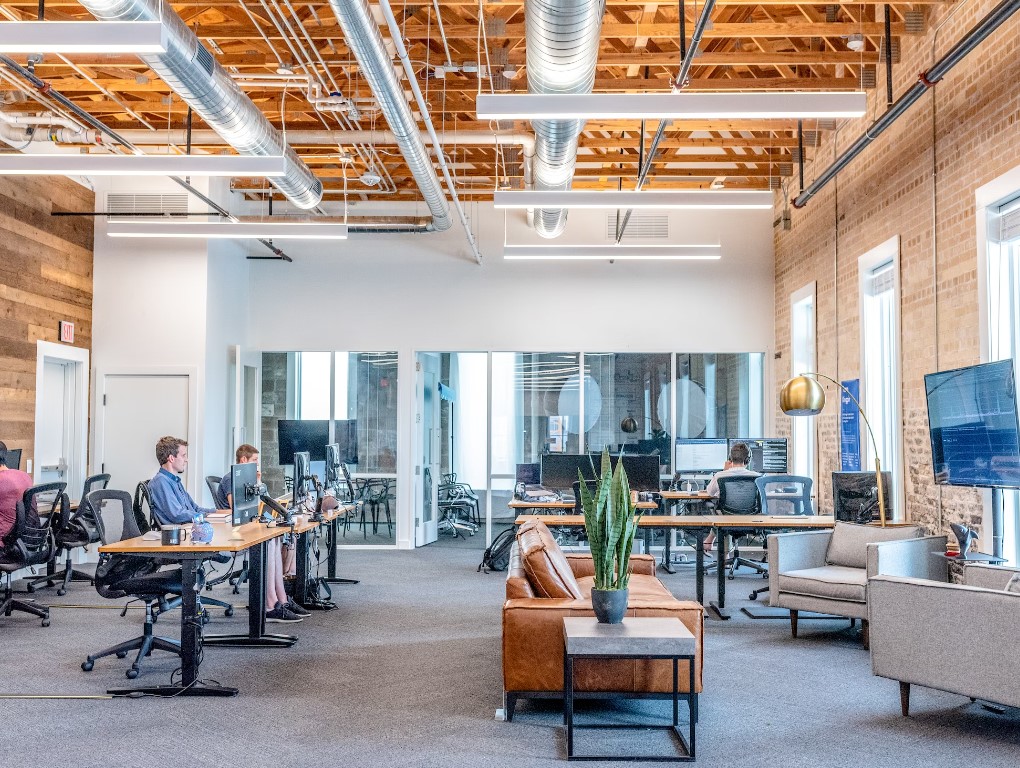
Energy Efficiency and Employee Productivity: Exploring the Connection
You may be curious as to how energy efficiency and employee productivity are linked, but the two are in fact close companions in the office environment. Let's explore how creating an energy-efficient workspace can lead to productive workdays and happier employees.
Firstly, temperature regulation plays a pivotal role. Energy-efficient offices often advocate for the right degree of temperature control. It's not too chilly during the winters, or too sweaty during balmy summer months. This balanced office temperature prevents discomfort, allowing your employees to concentrate on their tasks better.
Note: A study by Cornell University found that the optimal office temperature to support peak productivity is around 22 °C.
Secondly, optimal use of natural resources, another feature of sustainable workplaces, also has a positive impact. By harnessing sun rays for light and using natural ventilation, energy-efficient workplaces can cut down energy bills and decrease use of artificial lights and air-conditioners. Not only is this better for the planet, but working in naturally lit, well-ventilated spaces can also help to elevate employee mood, reduce fatigue and hence increase productivity.
Perhaps you've noticed how invigorated you feel on a sunny, fresh day. It turns out, there's actually science behind this. Natural light helps to regulate your circadian rhythm, that internal body clock which determines when you feel sleepy or alert. When you're exposed to plenty of sunlight, this rhythm functions optimally. As a result, you're likelier to feel alert and energetic during the day and to sleep well at night, which significantly boosts your productivity.
Now envision converting this energy boost into your everyday work routine. By capitalising on natural daylight in well-designed sustainable workplaces, employees get to enjoy these benefits consistently.
But it's not just the light that matters – it's also the air. Eco-friendly buildings often prioritise natural ventilation. This involves allowing fresh, outdoor air to circulate within the building, replacing stale, indoor air. Not only does this feel more refreshing and comfortable, but it carries significant health benefits. Those constantly fatigued by stale, poorly circulated air finally get to breathe easier and feel less lethargic.
The benefits of natural light and air flow extend beyond physical well-being, enhancing mental well-being too. A well-lit, well-ventilated workspace can reduce stress and improve mood, leading to happier and more motivated employees. These factors, in turn, drive better collaboration and team performance.
So the solution is clear – consider how you can redesign your office to allow more natural light and incoming fresh air. You may be surprised at how such simple tweaks can boost productivity and improve employee health and happiness.
In sum, the optimal use of natural resources in the workspace is a win-win. The environment benefits from reduced reliance on artificial energy, and your employees benefit from a healthier, more productive and rewarding work experience.
You can design green buildings with our Sustainable Architecture course!
Eco-friendly buildings, Life Cycle Assessment, Active vs. Passive Strategies, Analysis with energy models, and Efficient retrofit: we cover it all!
Through our Sustainable Architecure Course, you will learn how to apply building principles, strategies, and techniques for circular economy-based design

